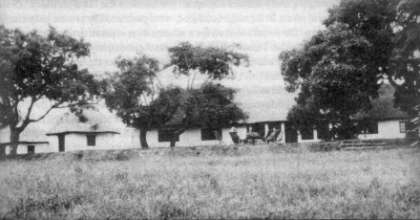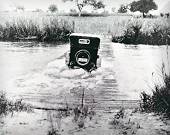|
|
History of Hazyview

Sabie River Bungalows in the 1930's
Photo: White River Museum
 The First Trading Post
The First Trading Post
 Six roads, coming from all directions, converge at Hazyview. The town
is situated on the farm De Rust, 35 km east of Sabie, about 35 km
north of White River and 53 km west of Skukuza.
Six roads, coming from all directions, converge at Hazyview. The town
is situated on the farm De Rust, 35 km east of Sabie, about 35 km
north of White River and 53 km west of Skukuza.
Because of it's distance from White
River, Sabie, Kruger National Park and Phalaborwa, it was the perfect
locality for a trading post and petrol filling station. The Village of
Hazyview was officially promulgated in 1959 when the first post office
was established and Hazyview Railway Station came into being when the
old Selati Railway line was diverted outside the western border of the
Kruger National Park to Kaapmuiden in the late 1960's.
|
Selati Railway Line
In 1887 gold was
discovered near Gravelotte in the Northern Transvaal. This
became known as the Selati Goldfields.
While the Eastern
Railway Line was being constructed from Komatipoort to
Pretoria in 1891, it was evident that the Soutpansberg area
(in the far Northern Transvaal) also needed fast rail
transport to Lourenco Marques (Maputo). This prompted
the Volksraad to approve the construction of a railway line
from Komatipoort, via the Selati Goldfields, to Zoekmekaar.
After laying 120km
of track from Komatipoort, the Selati line came to an abrupt
stop in 1894 at the Sabie River near Skukuza. This was
due to a corruption investigation into the affairs of the
concession holder, Baron Eugene Oppenheim. The Anglo-Boer War
(1899-1902) delayed the completion even further.
The Selati Line to
Zoemekaar was eventually completed in 1915 and later (in the
late 1960's) diverted to run outside the Kruger National Park
to the present railway station at Hazyview.
|
 Perry's Farm
Perry's Farm
Harry Wolhuter, the famous Kruger National Park game ranger, had a
friend named Perry, a French Canadian and member of Steinaecker's
Horse, a cavalry regiment in the South African War, who saved Harry's
life when he had Black water fever. Some time after the War, Perry was
granted a farm on the Sabie River by the Government, which he named
'Perry's Farm', on which he started a trading store. Having no family
he willed his farm to Harry and after his death and burial there,
Harry was obliged to sell the farm in order to liquidate the debts.
This farm was later to become the site of the Sabi River Bungalows,
now known as the Sabi River Sun, and the bridge over the Sabie River
as Perry's Bridge.
The farm De Rust used to belong to
Harry Wolhuter,. He sold the farm to HE Gillman and Eric Smothers.
Smothers donated a 5 morgen (1.25 ha) section of the farm for the establishment
of the Sabi-Sand Co-operative and Smothers' daughter (married to Peter
Batchelder), sold 5 morgen (1.25 ha) to the Sabi-Sand Co-operative for the
housing of the co-op's staff and for a tennis court.
|
Harry Wolhuter
Henry Christoffel
(Harry) Wolhuter (1876-1964) was born in Beaufort West. He later
relocated to the Lowveld to assist his parents on their farm
& trading store at Legogote, near White River.
During the
Anglo-Boer War, Harry joined a volunteer corps that was formed
under the leadership of Col. Baron Franz Ludwig von Steinaecker,
the commander of the famous 'Steinaecker's Horse'. At the close of the
Anglo-Boer War, Harry was appointed as a game ranger by Major
James Stevenson-Hamilton, the newly appointed Warden of the Sabi
Game Reserve.
In August 1903 Harry
was attacked by a lion some 14km north-east of Tshokwane. He was
badly injured, but succeeded in killing the lion with his
hunting knife. His distinguished
services in the Park continued until 1946 when, at the age of
69, he retired to settle on his farm 'Lindandene' just outside
White River.
He recorded his
adventures in his book "Memories of a Game Ranger",
published in 1948.
|
 The First Shopping Centre
The First Shopping Centre
The Sabi-Sand Co-operative was established
in 1955. At the same time the Blue Haze Garage was started and Peter
Batchelder negotiated with Roy Hurndall for a business complex in
Hazyview. Peter erected the buildings and Roy leased the building and
started Kiaat Traders, later changed to Hazyview Traders. This complex
also housed a medicine depot and a post office.
 The First Bananas
The First Bananas
Today the Kiepersol and Burgers Hall areas are one of the main banana
producing areas of the Lowveld. The man responsible for planting the
first banana orchards was Eduard Christiaan (Eddie) Joubert
(1891-1962).
 The First Hotel
The First Hotel
Captain Max Tylden-Wright and Charles Hull opened the first hotel on the
Sabie River in 1932 to service the visitors to the Kruger National Park,
hunters travelling to the north and various entrepreneurs in mining,
timber and farming. The Sabi River Bungalows consisted of 13 rondawels with private bathrooms, 6 single
rondawels for the chauffeurs, and a hot
mineral spring swimming pool. This was a very prestigious hotel and Lady
Louis Mountbatten, who visited in 1937, was but one of many famous
people who stayed there, along with the Oppenheimer, Engelhad and Anstey
families.
 The First Private Game Reserves
The First Private Game Reserves
East of Hazyview, on the road to the Kruger National Park, are the
well known game sanctuaries such as Londolozi, Sabi Sabi, MalaMala,
and others. The concept of nature reserves started after the
proclamation of the Kruger National Park in 1926. Until then farms in
the Lowveld were utilised for hunting purposes but with the
proclamation of the Park, conservation awareness was born. The portion
lying to the west of the Park, between the Sabie River in the south
and the Olifants River in the north, was the first area where the
concept of private nature reserves began.
In 1926 Charles Boyd Varty and Frank A
Unger, both ardent sportsmen and true lovers of wildlife, purchased
the farm Sparta, in the present Sabi Sand Wildtuin, and thus pioneered
the 'game farm' idea in this area. A year later W A (Wac) Campbell,
the patriarch of Natal Sugar Estates, and a foundation member of the
National Parks Board, bought MalaMala, Eyrefield and Marthly in this
reserve. and subsequently acquired several other adjacent farms.
During the early thirties almost all the farms in the 'Toulon Block'
(Sabi Sand), as well as several others in the neighbourhood, were
purchased by private individuals.
In 1934 some of the owners looked for a
scheme of co-operative game protection. They took their problem to the
Transvaal Land Owners Association (TLOA), which had many functions,
including the administration of unoccupied agricultural and game farms
for individuals or groups. The TLOA suggested that the Sabi Private
Game Scheme be formed. This name was changed in July 1948 to Sabi Sand
Wildtuin and formally proclaimed a private nature reserve on 27
January 1965.
Londolozi Game Reserve was one of the
first to be established in the Sabi Sand area. Londolozi Game Reserve
gives the meaning of their name as 'protector of all living things'.
The Zulu word Londolozi means 'protection' or 'preservation', while
the one who is the protector, preserver or guardian is known as the 'umlondi'.
The Londolozi Game Reserve is, therefore, not only the protector of
all living things, against such things as poachers, veld fires,
pollution, etc., but also the guardian and preserver of the
environment and its ecological system.
Source: Pioneers of the Lowveld by Hans
Bornman, 2006. ISBN 0-9584782-3-6
|


